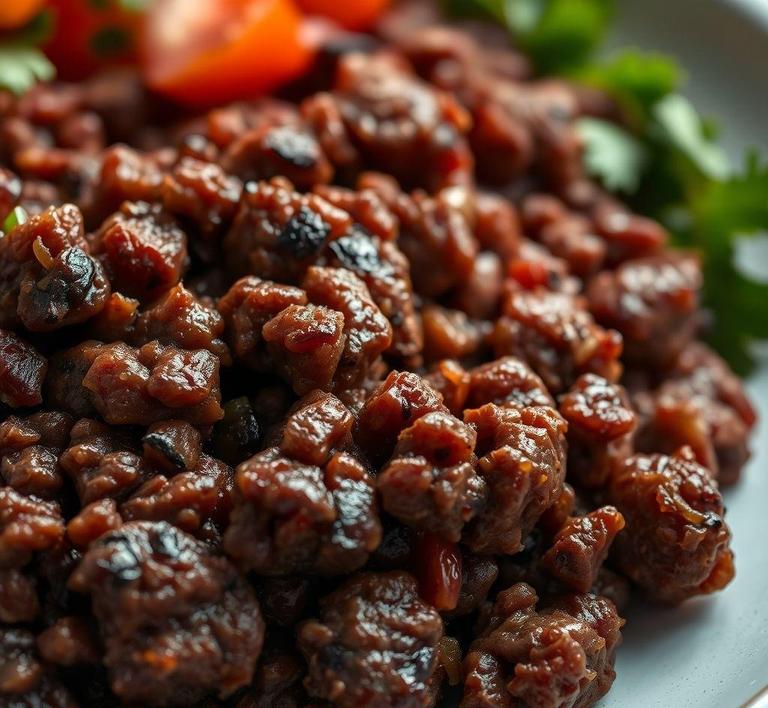Refreezing cooked ground beef is a topic that often sparks a bit of debate in the kitchen, but with the right approach, it can be done safely and efficiently. Whether you made too much for dinner or want to store leftovers for later, understanding how to properly handle and store cooked ground beef can save you both time and money. By following a few simple guidelines-like making sure the beef cools quickly, storing it in airtight containers, and reheating it thoroughly-you can keep your meals fresh without worrying about compromising quality or safety. Let’s dive into the essentials of refreezing cooked ground beef so you can make the most of your leftovers!
Can You Refreeze Cooked Ground Beef?

Yes, you can refreeze cooked ground beef, but it requires some careful consideration to ensure the best quality and food safety. When it comes to food safety, the key factor is how the beef was initially thawed and how it was stored throughout the process. Refreezing cooked ground beef isn’t as straightforward as freezing it once because of the potential risk of bacterial growth and quality degradation.
Ground beef, like all meat, should only be refrozen if it has been handled properly from start to finish. It’s important to know that once cooked ground beef is thawed, it enters the ‘danger zone’ (between 40°F and 140°F or 4°C to 60°C), where bacteria grow rapidly. Therefore, if cooked ground beef has been thawed at room temperature for more than two hours, it should not be refrozen. Additionally, it’s always best practice to refreeze the beef as soon as possible after cooking or thawing to prevent bacterial growth and reduce the risk of foodborne illnesses.
How To Refreeze Cooked Ground Beef?
Refreezing cooked ground beef should be done cautiously to retain its flavor, texture, and nutritional integrity. Here’s a step-by-step guide to help you do it right:
-
Cool the Beef Quickly:
Before refreezing, make sure the cooked ground beef is cooled down to room temperature or ideally to 40°F (4°C) or below. This can be done by spreading the beef out in a thin layer on a baking sheet or in shallow containers to speed up the cooling process. Avoid leaving the beef at room temperature for more than two hours to minimize bacterial growth.
-
Store Properly:
Once cooled, divide the cooked ground beef into portions that are appropriate for your future needs. Smaller portions freeze better and thaw more evenly, preventing the need to refreeze portions multiple times. Use airtight containers, freezer-safe bags, or vacuum-sealed bags to store the beef. Make sure to remove as much air as possible to prevent freezer burn, which can degrade the flavor and texture of the meat.
-
Label and Date:
Always label and date your containers. Ground beef is best used within 3-4 months of being refrozen for optimal taste and texture, but it can last up to 6 months in the freezer if properly stored.
-
Freeze Promptly:
Place the containers of cooked ground beef in the freezer as soon as possible. The sooner it is frozen after cooking, the better it will retain its quality. Be mindful of not overcrowding the freezer, as air circulation is important to maintain an even freezing process.
-
Thawing and Reheating:
When ready to use, thaw the refrozen cooked ground beef in the refrigerator overnight, or use a microwave for quicker thawing. Avoid thawing meat on the countertop, as it can lead to uneven thawing and allow bacteria to grow. Once thawed, make sure to reheat the beef thoroughly to a minimum of 165°F (74°C) before consuming.
Quality Impact
Refreezing cooked ground beef can affect its texture, flavor, and overall quality. Here’s how:
-
Texture:
When ground beef is frozen and thawed, the ice crystals that form can disrupt the muscle fibers in the meat. This can lead to a slightly more grainy or dry texture when you reheat it. While it may not be as tender or juicy as it was when freshly cooked, proper storage can minimize these changes.
-
Flavor:
The flavor of cooked ground beef can suffer a little after being frozen and refrozen, especially if it has been stored for a longer period. Freezer burn is a significant concern, and if the beef is not properly sealed or stored, the air exposure can lead to off-flavors. However, if you cook the beef with sauces, spices, or other ingredients, the flavor degradation will be less noticeable.
-
Nutritional Content:
Freezing and refreezing cooked ground beef will not drastically affect its nutritional content. The primary concern is the texture and flavor, rather than the loss of essential nutrients like protein or fat. However, improper storage and repeated freezing can cause some loss of moisture, which could slightly reduce the nutritional density.
-
Risk of Bacterial Growth:
As mentioned earlier, the biggest concern when refreezing cooked ground beef is the risk of bacterial contamination. If the beef is not cooled quickly enough or left out for too long before being frozen, bacteria like Salmonella and E. coli could grow. Therefore, careful handling and proper freezing techniques are crucial to ensure that the beef is safe to consume after refreezing.
Refreezing cooked ground beef is certainly possible, but it comes with some caveats. By following the right procedures-quickly cooling the beef, storing it in airtight containers, and adhering to proper thawing and reheating techniques-you can safely refreeze and enjoy cooked ground beef without sacrificing too much in terms of flavor or texture.
However, it’s essential to understand that refreezing will slightly degrade the quality of the meat. The texture may become a bit tougher and drier, and the flavor may be less vibrant, especially if the beef has been frozen for a long time. If you’re looking to avoid these minor changes, it’s best to only freeze what you intend to eat within a short period, ideally within 3-4 months.
The most critical factor is food safety. As long as the cooked ground beef has been handled properly and not left at room temperature for extended periods, it is safe to refreeze. Always check for signs of freezer burn or an off smell when thawing, and when in doubt, it’s better to discard the meat than take the risk of consuming spoiled food.
Is It Safe To Refreeze Cooked Ground Beef?
Refreezing cooked ground beef can be a bit of a tricky topic. In general, the safety of refreezing cooked ground beef hinges on a few factors: how the meat was handled, how it was cooked, and how long it has been sitting at room temperature. When you cook ground beef, the heat kills harmful bacteria, but once it’s thawed, there’s the potential for bacteria to multiply if it is not handled properly. The key to ensuring safety lies in the timing of the refreezing process and how the beef has been stored.
Refreezing Cooked Ground Beef Is Generally Safe Under The Following Conditions
- Thawed and Handled Properly: If the cooked ground beef was thawed in the refrigerator and not left out for extended periods, it should be safe to refreeze. The USDA advises that meat should not sit out for more than two hours at room temperature (or one hour if it’s above 90°F). If the beef was thawed at room temperature, refreezing is not recommended because it can cause the growth of harmful bacteria that might not be destroyed even by reheating.
- Temperature Management: To ensure safety, the cooked ground beef should be cooled rapidly and stored in the fridge (below 40°F) or frozen at 0°F. If the meat was left at a higher temperature for any extended period, refreezing could make it unsafe to eat. When meat is refrozen, you also risk diminishing its texture and flavor, but it doesn’t make the food inherently dangerous unless mishandled.
- Refreezing Once: According to food safety guidelines, it is generally safe to refreeze cooked ground beef only once after it has been thawed. Multiple cycles of freezing and thawing can cause quality degradation, and more importantly, increase the risk of bacterial contamination. The fewer times food is frozen and thawed, the better.
In summary, refreezing cooked ground beef is safe as long as it was handled properly, thawed safely, and hasn’t been sitting at room temperature for too long. Always be cautious and ensure that the beef is at the correct temperature before refreezing it.
Signs That Cooked Ground Beef Should Not Be Refrozen
While it’s often safe to refreeze cooked ground beef, there are some telltale signs that indicate the meat should not be refrozen under any circumstances. These signs are often related to improper handling or spoilage, and they can be an indication that the meat could pose a health risk.
- Off Smell: If cooked ground beef smells sour, rancid, or just “off”, this is a clear indication that bacteria or other microorganisms have started to proliferate in the meat. Smell is one of the easiest ways to tell if the meat has gone bad. If the beef has a foul odor, it is best to discard it rather than refreezing.
- Discoloration: While cooked ground beef can change color slightly after being frozen and thawed (usually becoming a little darker), drastic changes in color-like the meat turning grey or green-are a sign that bacteria or mold may be present. Any signs of mold on the surface of the beef are also a clear indication that it’s not safe to refreeze.
- Slimy Texture: Ground beef, when it starts to spoil, can develop a slimy, tacky, or sticky texture. If you touch the meat and it feels slippery or sticky, this means that it has likely gone bad and should not be refrozen. This is often a sign of bacterial growth, which can cause foodborne illness.
- Excessive Leaking Liquids: If your cooked ground beef has been thawing or stored improperly, it might leak excessive amounts of liquid. This liquid can be a breeding ground for bacteria, so if the beef is too watery or pooling liquids have developed around it, it should not be refrozen.
- Extended Time at Room Temperature: If the cooked ground beef was left at room temperature for more than two hours (or one hour in hot environments), it is unsafe to refreeze. Even if the beef appears to be fine, prolonged exposure to warmer temperatures promotes bacterial growth, which could lead to food poisoning.
If you notice any of these signs, discard the cooked ground beef rather than risk eating it after refreezing. It’s always better to err on the side of caution when it comes to food safety.
Common Refreezing Mistakes
Refreezing cooked ground beef sounds like a simple enough task, but many people make mistakes along the way that can compromise the quality of the meat or pose health risks. Below are some of the most common mistakes made when refreezing cooked ground beef:
- Thawing at Room Temperature: One of the biggest mistakes people make is thawing cooked ground beef at room temperature before attempting to refreeze it. The USDA recommends that cooked meats should always be thawed in the refrigerator or using a microwave (if you plan to cook it immediately). Letting meat sit out at room temperature for hours encourages bacterial growth, and refreezing it afterward can trap the bacteria inside.
- Refreezing Multiple Times: Refreezing cooked ground beef multiple times isn’t just bad for the texture-it’s also dangerous. Each cycle of freezing and thawing can encourage bacterial growth, and the more times food is thawed and refrozen, the greater the risk of contamination. Ideally, you should refreeze only once, and only if the meat was thawed in a safe way.
- Freezing Without Proper Packaging: Failing to properly package cooked ground beef for freezing is another common mistake. If it’s not wrapped tightly or stored in an airtight container, the meat can suffer from freezer burn. Freezer burn doesn’t make the food unsafe, but it will affect its flavor and texture, making it less pleasant to eat. Make sure to use heavy-duty freezer bags or airtight containers when storing cooked ground beef in the freezer.
- Not Cooling Beef Quickly Enough: After cooking, cooked ground beef should be cooled quickly before being placed in the fridge or freezer. If you place hot beef directly in the fridge or freezer, it could raise the temperature inside the appliance and create unsafe conditions for other stored foods. To cool the beef quickly, spread it out in a shallow container or use an ice bath.
- Leaving Beef Unwrapped or Poorly Wrapped: If you store cooked ground beef in the fridge or freezer without wrapping it properly, the air can get to it and promote freezer burn or spoilage. Even in the freezer, ground beef should be tightly wrapped to prevent any air from getting in. Freezer bags or vacuum sealing are good options to ensure freshness.
Tips And Tricks For Refreezing Cooked Ground Beef
To make the process of refreezing cooked ground beef as smooth and safe as possible, here are some helpful tips and tricks:
- Portion Control: When you cook ground beef, consider portioning it into smaller, meal-sized portions before freezing. This way, you can thaw only the amount you need and avoid having to refreeze the leftovers. It also reduces the risk of spoilage, as smaller portions cool faster and can be consumed more quickly.
- Use Airtight Containers: Invest in freezer-safe, airtight containers or heavy-duty freezer bags to store your cooked ground beef. Squeeze out as much air as possible to prevent freezer burn and preserve the quality of the meat.
- Label and Date: Always label your containers or bags with the date you cooked and froze the beef. This way, you’ll know how long it has been stored and when it might be best to use it. Cooked ground beef should ideally be eaten within 2 to 3 months of freezing for optimal taste and texture.
- Cool Meat Quickly: To prevent bacteria growth, make sure the cooked ground beef cools rapidly before going into the fridge or freezer. You can speed up the process by dividing it into smaller portions or placing the container in a shallow ice bath.
- Avoid Refreezing Meat That’s Already Been Refrozen: If you’ve already thawed and refrozen your ground beef once, it’s best to consume it and not attempt to refreeze it again. Multiple cycles of freezing and thawing reduce the meat’s safety and quality, so stick to the ‘one-time’ rule.
Conclusion
Refreezing cooked ground beef can be done safely, but it’s important to follow food safety guidelines closely to avoid health risks and preserve the quality of the meat. Key factors include proper storage, quick cooling, and ensuring that the meat has been thawed and handled correctly. Recognizing the signs that cooked ground beef is no longer safe to refreeze-such as off smells, sliminess, or discoloration-can help you avoid foodborne illness. By keeping these tips and tricks in mind, you can confidently refreeze cooked ground beef when needed while ensuring that it remains safe to eat and as tasty as possible.


